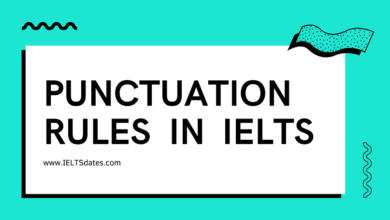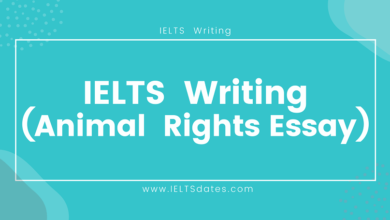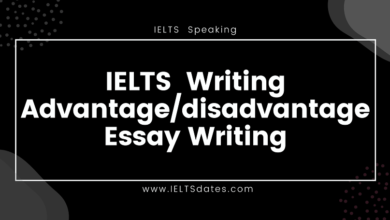IELTS Academic Writing Task 1: A Complete Guide for all
Academic IELTS Writing Section
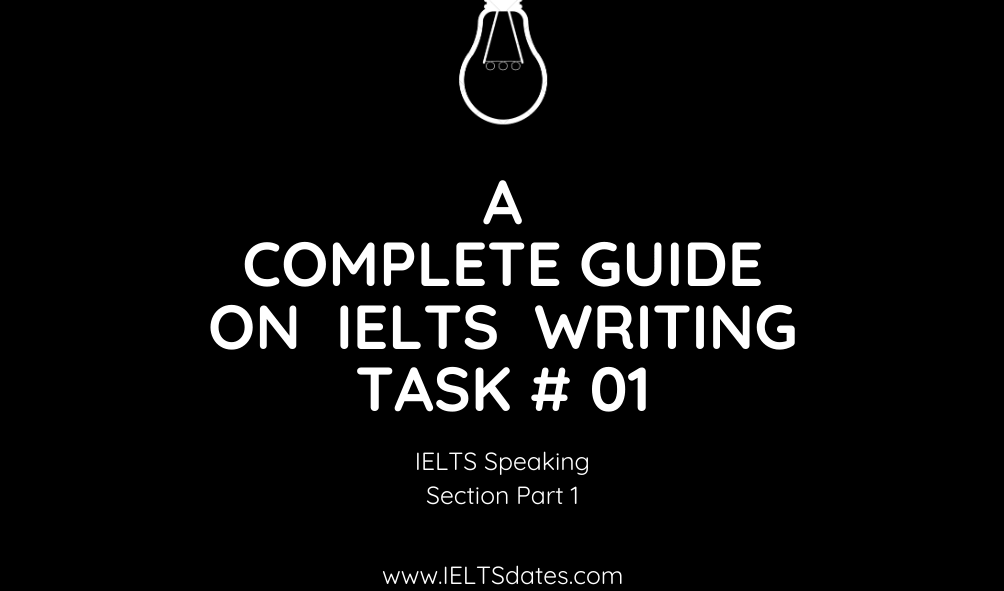
In the writing section of the Academic IELTS, you have to write a response to two tasks and the time duration for completing both of the tasks is 60 minutes or one hour. In task 1 you have to summarize the information or in other words, you have to write a report on the pictures given to you. These pictures are the graphs, charts or some diagrams giving you some information.
Moreover, there can be one or two pictures given to write a response. So, keeping the basic pattern of question 1 it can be seen that task 1 of the IELTS academic is foreseeable exercise. And if you know correctly how to attempt the exercise then you can apply the pattern to any of the given topics. In this article, we will explain everything about the writing task 1 in IELTS academic. Additionally, we have also explained the sample question and have also given you some of the tips by which you can increase your score.
Basics of Writing Task 1 in IELTS Academic
For task 1 you have only 20 minutes to write a response. You have to write a minimum of 150 words. Writing a response to task 1 is very similar to writing a report which an employee submits to their supervisors in order to tell them facts about something. So, according to this, in task 1 you just have to write those facts which you see in the figure or figures and you have to note down the summary of what you are seeing in the picture.
One of the important categories according to which the writings in the IELTS section are scored is Task Achievement. It is among the four categories according to which the writings are evaluated. However, the task achievement is scored on the basis of how accurately, relevantly and appropriately you have written the repose towards the given picture while using only 150 words.
So, this means that you need to follow all directions if you want to have a good score in the category of task achievement. Additionally, this means that you are not allowed to write those details which do not belong to the figure or are not relevant and appropriate to the given picture. So, now the question here is that what information should be written so you get a good score?
However, you can get the answer to this question later in this article. This is because we have explained the template of task 1 and have also given some advice which will help you gain a good score.
Please note: There are different approaches to write Task 1 of academic IELTS mentioned in different study materials which help you prepare well for the exam. Moreover, there are many good ways by which you can answer the task 1 question. However, following we have mentioned the approach which is straightforward and will help you to write the task 1 response. We have assured we mention all of the requirements by which you can gain a good score in task 1. So, if you learn properly, then you will have confidence in writing a response of task 1.
Steps and timing for task 1 of the writing section of IELTS Academic
Time management is very important if you want to get a good score in the writing section of IELTS academic. Time management depends upon your writing speed and if you have done the prewriting which includes outlining, note-taking, brainstorming, etc or not. So, keeping this in mind, we have devised a pacing plan which will work great for the test takers. However, you can always do some modifications according to yourself.
The following are the steps by which you can manage your time wisely:
- Read the question and plan your essay in the first 3 to 5 minutes.
- Write the response in the next 10 to 15 minutes.
- Finally, proofread the essay and making the corrections in the last 3 to 5 minutes.
While you practice writing, make sure you don’t develop the habit of writing too much detailed information in your response. Additionally, always practice by dividing time into chunks so that it will be easy for you to manage time.
Moreover, make sure that you relate the accurate information with the figure while proofreading and writing the essay. If your graphs or charts are very complex then you should write simple information, avoiding the detailed information, and just giving the overview. On the other hand, if the figure is not complex then make sure you write every detail about the figure giving the detailed information.
Task 1 against Task 2
If you already know about the format of the IELTS academic then you must be aware of the fact that two tasks of the IELTS writing section are very different from one another. As in the first task you have to write a report on the figure given to you. And in the second task, you have to write an essay in which you have to give the opinion on some issue in at least five paragraphs.
Additionally, this is to be noted that task 2 is of more points and you have more time to complete the task. Therefore, students get tempted to write task 2 first and complete task 1 later. However, we suggest you that you should never use this approach even if task 2 is of more marks. Task 1 can also give you points if you prepare and write well. Moreover, task 1 is easy to attempt as it is predictable and requires the same strategy to attempt any given picture in few minutes without wasting your time.
Before you start Writing: Acquire to “Read” the questions of Writing Task of IELTS Academic
Understanding the question of the IELTS task 1 is very important as it will help you to write the response very accurately. So, before we see the template let us discuss what we need to do while reading the question. Keep in mind that you just have 20 odd minutes to write a response, so when you get the booklet run towards reading the question.
Here note that reading the question does not mean that you understand everything at once. Just make sure that you understand what is in the question and how do you need to plan the response for it by including the necessary details.
Keep in mind: At first glance, the visuals in the IELTS exam will look very difficult but you don’t have to panic. This is because in the test your analyzing abilities are not tested nor you are required to do the calculations which are very complicated. Actually, the question needs to assess the writing abilities of the candidates in the English language. Moreover, the examiner wants to know how appropriately and accurately you have the ability to report the information present in the graphs, diagrams, charts, etc. Therefore, if you practice the strategies listed below for reading the questions then you will be able to have all the information needed to write a response that will give you good marks.
How should you “Read” the Question of Task 1 in IELTS Academic writing?
1. Read the titles and summary first
In the instructions for the writing task, you will find a sentence showing an overall summary of the question. Additionally, the figure you are provided with also contains the title which gives you an overview. So, always make sure you read these first. Moreover, the summary information is very useful when you start writing the introduction of your report.
2. Take notes
The next step is taking notes about the information you get from the visual. In order to gain a high score, you must comprehend the accurate details from the visual and then write them down. Don’t start writing before taking the notes as they will help you a lot in structuring your essay. Moreover, after having a look at the visual ask yourself the following questions.
- Is the time involved in the visual? Is there hours, weeks, days, months, years, etc are presented?
- Does the graph show some trends? If yes, then what are those trends? Are they decreasing, increasing, fluctuating, etc?
- Do your visual shows some events? Are there different steps?
- Is there various kind of categories of things?
- Does the visual present numbers in thousands, hundreds, percentages, millions, etc?
3. Finding an “angle” in the data
After you have grasped the idea of the visual, next you have to see the main features in the visual or in other words what is it trying to convey actually. You have to find an appropriate angle that will help you report the information. Anyhow, taking the decision of which information to include and which should be left out is a difficult task. But if you have found the right angle then it won’t be difficult for you.
For example, you are given a graph that shows the popularity of the 5 TV shows. Moreover, these shows are ranked according to the admiration among various age group groups. So, the following will be the possible angles you should look for.
- Shows that are more and least popular among every age group.
- Shows that became more and more popular as the age of the viewers increased or decreased.
- Shows that were popular for only one age group.
So, the angles are one which will be the most interesting thing about the visual. In other words, you can also think like this that if you have to present a report to the class then what kind of information you will pick up, that will make your report very interesting. The reaction to this will make most of your task 1 content. So, always try that you find some interesting angles in the visuals.
Template Overview of Task 1 in IELTS academic
The template of task 1 in writing section contains the following things
- The first paragraph contains the introduction of the visual in 1 or 2 sentences.
- In the second paragraph, a summary of the visual is given.
- The third paragraph includes the key feature present in the visual.
- And in there is a conclusion which is optional.
Following we will go through the different parts of the IELTS writing section task 1. The template contains a complete response to the given question. To give you the real sense of the exam we have also provided the question for which the response is written. Moreover, it will help you to grab the technique of looking at the question and making the decision of what to write and whatnot.
The question for writing task 1 is as follows:
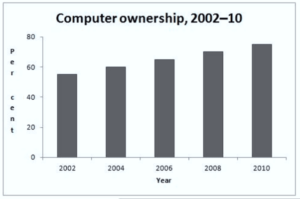
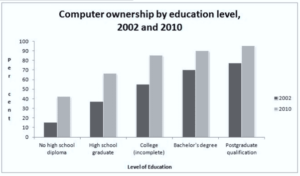
The above-given graphs show information about the percentage of owners of computers among the population from the year 2002 to 2010. Additionally, by education level from the year 2002 to 2010.
Summarize the main points from the above graphs by writing key features and by making the comparisons where they are needed.
Write a minimum of 150 words.
Paragraph 1: Introduction of the Visuals in 1 or 2 sentences
Writing the introduction of the graphs is simple but it can be sometimes challenging because it assesses the vocabulary and grammar of the candidates. So, what you have to do is to explain the visual in general terms. And you have to use one or two sentences maximum to give the introduction.
Fortunately, it is very easy to write because you have the answers to this in the question. For example, in our example question, you can see that this information is given after the words “The graphs above give information about”. Moreover, the visual titles also give you all of the information you need to write in paragraph one.
Writing the introduction requires practice as you have to rephrase the words from the question without actually copying the words. So, this means that you have to write the given information in your words. Always remember, that you don’t have to use the same sentences and vocabulary. And if you fail in doing this then it will cost you marks. Moreover, note that in IELTS your grammar and vocabulary are tested. But also keep a note of this, that it is not necessary that you paraphrase the key terms also. For example, in the above example the phrase such as “computer ownership” cannot be paraphrased but other phrases can be.
Following is the example introduction of the above visuals. Note that, the sentences and vocabulary are not copied but paraphrased.
The given charts show computer ownership percentages from the year 2002 to 2010. Moreover, the second graph also shows the ownership by education level in the population.
Paragraph 2: Write the Summary of the visuals in 2 to 4 sentences
In the following paragraphs after the introduction, you have to provide a summary of graphs excluding the unnecessary details. Remember that the question also tells you the same that you have to report just the main features without going into too many details.
If you focus on just writing the main points, then it will help you avoid the unnecessary details that make your writing boring and not interesting. You don’t have to write a lot of figures and the numbers in your summary. Moreover, if you want to include them then you can write them in the third paragraph. As in the second paragraph, you just have to give an overview of what are the main points in your graphs which you want to include.
In the first paragraph, you explained what is visual about. Now in the second paragraph, you have to explain the information that is very interesting about the graphs and what are they actually trying to tell. You have to write that information which is most important. It can be a striking overall pattern or a general trend. Therefore, in the second paragraph, you just have to report general information which seems to be very important in the graphs. See the example below.
The graphs show the continuous increase in computer ownership among the population during the timeframe of eight years. Moreover, the increasing trend is seen across every education level. However, it can be seen that with the increase in education the ownership of computers has also been increased during the year 2002 to 2010.
Paragraphs 3 & 4: Write key features in detail
As you have given the summary of major information in the pictures, now you have to give further details of the graphs in the third paragraph. In this paragraph, you have to give some detailed information about the facts and figures you see in the graph. But keep in mind that you do not need to give unnecessary details which will make your report too long and make the examiner bored. So, you need to make a choice of which information to write and which not. And always try that you write the details of that information which is very important.
So according to our template, we have mentioned in the second paragraph that how much the computer ownership has increased from the year 2002 to 2010 and the owner has also increased among people who are not well educated. In the third paragraph, we will explain further these key points and will give detailed information. Or in other words, we will explain the angles in the data in the third paragraph.
However, while writing the further information you have to make one decision. And that is if you will explain everything in one paragraph or will divide into two paraphrases which will be shorter in length.
Note that it is not important to add the fourth paragraph in the summary as it will not give you additional marks. But splitting the bigger paragraph into shorter paragraphs is a good practice. This makes it easy for the examiner to read and also give a structure to your writing. Moreover, splitting the third paragraph into two is good when you have to explain two different features in the data. As it will present the information clearly. So, because of this, we have also included two shorter paragraphs in a template to explain the information more clearly.
The following are the third and fourth paragraphs of the template question:
In the year 2002, it can be seen that half of the population was having computers. This number gradually increased to 75% in the next 8 years. Postgraduate people were always having more ownership of computers than the others in the population. In the year 2002, only three-quarters of the postgraduates owned the computers, but this percentage increased to 95% in the year 2010. In contrast to this, people who hadn’t completed high school showed an increase in computer ownership of 45% after a period of eight years.
Notably, it can be seen that the other three groups which were not having higher education showed a gradual increase in computer ownership over a period of eight years. Moreover, the percentage increased by approximately to a greater 30 percent. Postgraduates and the students of college showed a more significant gain in computer ownership of greater 20% between the period of 2002- 2010.
An optional last concluding sentence:
It is optional to include the concluding sentence in task 1 of the writing section of IELTS academic. However, it can be helpful if you are lacking the words and have to complete the minimum 150 words count. Otherwise, you may skip including the concluding sentence.
However, the following is the concluding sentence for our template question mentioned above.
The opening era of the 21st century showed a significant gain in computer ownership between the people belonging to different levels of education.
Apart from the Template here are some of the tips to increase your score in writing section of IELTS Academic
When you start studying for task 1 of the writing section you must set some goals which you should achieve while writing your response. So, in order to achieve a good score, you must know the scoring categories under which the writings are scored. Therefore, following we have mentioned some tips which you can follow to get a good score in the writing section.
Scoring Categories of task 1 in IELTS writing section
Task Achievement
As mentioned before, this category measures if you have completed your task accurately or not by following the instructions. Moreover, you can look at the above template if you want to have an example that depicts the task achievement category accurately.
Grammatical Range and Accuracy
This category measures how well you have used grammar and with how much variety. If there are grammatical mistakes in your writing then, of course, you will lose marks. To practice good grammar skills, you must take some English classes or invest your time in reading a grammar book. There are many grammar books available online and in the market which you can buy and study at home with ease if you do not want to take an English class. Moreover, these grammar books contain a lot of exercises which help you to build good grammatical skills.
The following are some of the extra tips to improve grammar skills if you are lacking time and can’t read a book or take a class.
Tip 1: Do not write simple sentences again & again
Whenever you write a response towards the example question make sure to look closely at the structure of the sentences. Always try that your sentence structure is not too simple. Most of the times many people have a habit to write the “BE” form of the verb. This means that they use the words like am, are, is, were, were, etc as the sentence main verb. However, this does not mean that you should not use “BE” verbs, but it means that you should not use it vet frequently as it makes your writings very basic. And most importantly usage of “BE” verbs also limits the range of grammar.
Additionally, try to use the verbs which are descriptive as they will help you write a wider range of grammar. For example, you can always use the adverbial phrases or adverbs to define the action. On the other hand, if you use only “BE” verbs then you can only use the adjectives for the purpose of description.
In order to practice this, make sure you go through every practice essay of yours and then try changing the sentences that have the “BE” verb used as the main verb. However, you don’t have to be concerned about those sentences which contain the “BE” verb like follows
She is eating.
In the sentence above the “eating” is the main verb and on the other hand, “is” is used as an auxiliary verb. So, you don’t have to change these kinds of sentences. But you need to change those sentences which look like following
Rachel is a science teacher at the school.
So, in the sentence above “is” is used as a main verb, which means it needs changing. However, keep in mind that whenever you change these kinds of sentences, they must fit into your essay logically. Anyhow, that this can be tough but it helps you a lot in knowing the structure of the sentences and the descriptive adverbs and verbs.
Keep note that, it does not mean that you have to ignore all of the “BE” verbs in your writings. The exercise mentioned above is just told so, that you make a habit of using a wide variety of grammar. Have a look at the example below
Original sentence: Rachel is a very good professor, so pupils always enjoy learning from her.
Revised sentence: Rachel delivers the lecture so brilliantly that pupils always enjoy learning from her.
Tip 2: Make use of complex sentence
In the IELTS exam, you have to show your ability to write complex sentences so that you can get a good score. Therefore, always remember that you use complex sentences in the writings.
So, the question here is what type of sentence is a complex sentence? Sentences which are complex include the “subordinating conjunctions”. These “subordinating conjunctions,” helps introduce the dependent clauses in the sentences. The following are examples of the subordinating conjunctions.
| Adverbial Subordinators
| Even though Whereas While When Because Since |
| Adjective Clause Subordinators: | Who Whom Which That Whose |
| Noun Clause Subordinators: | What When Where How Who |
Examples of complex sentences
Adverbial:
Even though it was raining today, we enjoyed it a lot.
I love playing cricket because it keeps the body healthy.
Adjective:
I flung the basketball to a colleague, who wasn’t prepared to catch.
Unfortunately, I am unable to understand what you taught me.
Noun clause:
I didn’t understand what you whispered.
Keep in mind, that you don’t have to overuse the sentences which are very complex. Your writings should be a mixture of simple and complex sentences making the information clear to the examiner. Moreover, there are many students who confuse long sentences with complex ones. You should always avoid those sentences which are very long so that you make your writings easy to comprehend.
Tip 3: Checking the tenses of verbs
Always try to write accurate verb tenses as if you don’t use them right then they will cost you marks. If it’s possible for you, then make sure you find some teachers who can evaluate your practice writings so that you have a good score.
One of the factors which makes usage of the wrong tense easier is the limited time. Many students make these kinds of mistakes because of the time pressure. However, if you think that you are making such mistakes then don’t panic. As you don’t always have to change all of the sentences but only the verbs mostly. Therefore, make sure that you have some time to review your writing before you finally submit it.
Whenever you are doing some practice writings make sure that you spend some time reviewing your writing as it will be built up your habit of reviewing. Moreover, you can also recheck your previous essays as reviewing them, again and again, will help you find more errors and you will learn more.
Lexical Resource
The meaning of the lexical resource is vocabulary. Always try that you add good vocabulary words in the writings that are most uncommon and unusual. For example, you can write cutting-technology instead of using the word modern technology in your writings. However, neither consider lexical resource as a rocket science nor think that you have to use very fancy words to impress the examiner. Just keep in mind that you have to use sufficient vocabulary according to the topic.
Practice Paraphrasing
One of the tips to get a good score in IELTS writing is that you should not copy the words from the question as it will cost you marks. If you copy the words, then the examiner does not thinks of you as a good writer and develops a bad impression about you. So, try to refrain from copying the words as you can always use synonyms. While practicing writing the response make sure you develop have a habit of paraphrasing the words so that the examiner gives you a good score.
Avoid Redundancy
While writing or speaking in the IELTS test make sure you do not use the same words again and again as they can cost you marks. Try not to use common verbs, adjectives, and nouns. For example, if you used a word growing in the sentence then do not use that similar word in other sentences. In contrary to this you can use words like burgeoning or increasing. So, keep in mind that you should know synonyms to the words as this impresses the examiner and you can get a good score. Moreover, there are very advanced synonyms available for the different range of words that you can use and influence the examiner. For words like decrease or increase, you can use the following synonyms:
- Go up – Go down
- Rise – Fall
- Spike – Dip
- Jump – Decline
- Skyrocket – Plummet
However, if you see in your practice writings that you are using some of the words many times then try to find some synonyms for those words. For finding the synonyms thesaurus is always helpful. Moreover, you can also check for new words and try to get some feedback from the person who has very good English skills. Anyhow, keep in mind that you cannot use all of the synonyms for every word, as all synonyms cannot fit all of the situations.
Coherence and Cohesion
This category measures how clearly and logically you have presented your ideas. Or in other words, you can say that the examiner examines your ability to present information in a logical and clear way.
Transition phrases and words
You can improve Cohesion and Coherence by learning and practicing more and more transition words. You can learn many transition words from the sources given online. If you learn many of them then you will have a variety of phrases and words from which you can write and make your writings interesting and worth reading. But also keep in mind that you should not use the phrase or words again and again as they may cost you marks. Moreover, also make sure that you avoid usage of transition words in each sentence. Only make use of them when you have to demonstrate some connection between the ideas.
Referencing
Another thing that relates to cohesion and coherence is referencing. The referencing is the ability of the candidate to make use of the different pronouns appropriately and accurately.
For example, I learned cooking from my mother. However, it took me extensive time to acquire.
In the sentences above the word “it” refers to the cooking.
So, referencing in your writings helps to remove redundancy from the writings as you don’t have to use the same nouns many times again. Moreover, it helps in linking the idea and keeps the sentences together.
The Template
The last thing, the examiner checks in your writings under the cohesion and coherence category is how well your writing response is organized. This means that you should logically organize the paragraphs and the information you present should be very clear. You should use transition words as well as references to make your writings perfect. If you see the above template, then you can see the cohesion and coherence in the writing and if you master it then definitely you can get a good score.
